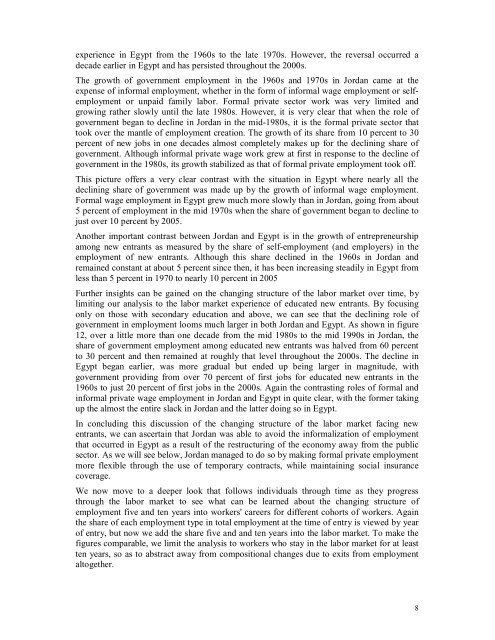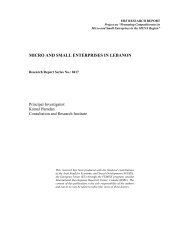The Structure and Evolution of Employment in Jordan - University of ...
The Structure and Evolution of Employment in Jordan - University of ...
The Structure and Evolution of Employment in Jordan - University of ...
You also want an ePaper? Increase the reach of your titles
YUMPU automatically turns print PDFs into web optimized ePapers that Google loves.
experience <strong>in</strong> Egypt from the 1960s to the late 1970s. However, the reversal occurred adecade earlier <strong>in</strong> Egypt <strong>and</strong> has persisted throughout the 2000s.<strong>The</strong> growth <strong>of</strong> government employment <strong>in</strong> the 1960s <strong>and</strong> 1970s <strong>in</strong> <strong>Jordan</strong> came at theexpense <strong>of</strong> <strong>in</strong>formal employment, whether <strong>in</strong> the form <strong>of</strong> <strong>in</strong>formal wage employment or selfemploymentor unpaid family labor. Formal private sector work was very limited <strong>and</strong>grow<strong>in</strong>g rather slowly until the late 1980s. However, it is very clear that when the role <strong>of</strong>government began to decl<strong>in</strong>e <strong>in</strong> <strong>Jordan</strong> <strong>in</strong> the mid-1980s, it is the formal private sector thattook over the mantle <strong>of</strong> employment creation. <strong>The</strong> growth <strong>of</strong> its share from 10 percent to 30percent <strong>of</strong> new jobs <strong>in</strong> one decades almost completely makes up for the decl<strong>in</strong><strong>in</strong>g share <strong>of</strong>government. Although <strong>in</strong>formal private wage work grew at first <strong>in</strong> response to the decl<strong>in</strong>e <strong>of</strong>government <strong>in</strong> the 1980s, its growth stabilized as that <strong>of</strong> formal private employment took <strong>of</strong>f.This picture <strong>of</strong>fers a very clear contrast with the situation <strong>in</strong> Egypt where nearly all thedecl<strong>in</strong><strong>in</strong>g share <strong>of</strong> government was made up by the growth <strong>of</strong> <strong>in</strong>formal wage employment.Formal wage employment <strong>in</strong> Egypt grew much more slowly than <strong>in</strong> <strong>Jordan</strong>, go<strong>in</strong>g from about5 percent <strong>of</strong> employment <strong>in</strong> the mid 1970s when the share <strong>of</strong> government began to decl<strong>in</strong>e tojust over 10 percent by 2005.Another important contrast between <strong>Jordan</strong> <strong>and</strong> Egypt is <strong>in</strong> the growth <strong>of</strong> entrepreneurshipamong new entrants as measured by the share <strong>of</strong> self-employment (<strong>and</strong> employers) <strong>in</strong> theemployment <strong>of</strong> new entrants. Although this share decl<strong>in</strong>ed <strong>in</strong> the 1960s <strong>in</strong> <strong>Jordan</strong> <strong>and</strong>rema<strong>in</strong>ed constant at about 5 percent s<strong>in</strong>ce then, it has been <strong>in</strong>creas<strong>in</strong>g steadily <strong>in</strong> Egypt fromless than 5 percent <strong>in</strong> 1970 to nearly 10 percent <strong>in</strong> 2005Further <strong>in</strong>sights can be ga<strong>in</strong>ed on the chang<strong>in</strong>g structure <strong>of</strong> the labor market over time, bylimit<strong>in</strong>g our analysis to the labor market experience <strong>of</strong> educated new entrants. By focus<strong>in</strong>gonly on those with secondary education <strong>and</strong> above, we can see that the decl<strong>in</strong><strong>in</strong>g role <strong>of</strong>government <strong>in</strong> employment looms much larger <strong>in</strong> both <strong>Jordan</strong> <strong>and</strong> Egypt. As shown <strong>in</strong> figure12, over a little more than one decade from the mid 1980s to the mid 1990s <strong>in</strong> <strong>Jordan</strong>, theshare <strong>of</strong> government employment among educated new entrants was halved from 60 percentto 30 percent <strong>and</strong> then rema<strong>in</strong>ed at roughly that level throughout the 2000s. <strong>The</strong> decl<strong>in</strong>e <strong>in</strong>Egypt began earlier, was more gradual but ended up be<strong>in</strong>g larger <strong>in</strong> magnitude, withgovernment provid<strong>in</strong>g from over 70 percent <strong>of</strong> first jobs for educated new entrants <strong>in</strong> the1960s to just 20 percent <strong>of</strong> first jobs <strong>in</strong> the 2000s. Aga<strong>in</strong> the contrast<strong>in</strong>g roles <strong>of</strong> formal <strong>and</strong><strong>in</strong>formal private wage employment <strong>in</strong> <strong>Jordan</strong> <strong>and</strong> Egypt <strong>in</strong> quite clear, with the former tak<strong>in</strong>gup the almost the entire slack <strong>in</strong> <strong>Jordan</strong> <strong>and</strong> the latter do<strong>in</strong>g so <strong>in</strong> Egypt.In conclud<strong>in</strong>g this discussion <strong>of</strong> the chang<strong>in</strong>g structure <strong>of</strong> the labor market fac<strong>in</strong>g newentrants, we can ascerta<strong>in</strong> that <strong>Jordan</strong> was able to avoid the <strong>in</strong>formalization <strong>of</strong> employmentthat occurred <strong>in</strong> Egypt as a result <strong>of</strong> the restructur<strong>in</strong>g <strong>of</strong> the economy away from the publicsector. As we will see below, <strong>Jordan</strong> managed to do so by mak<strong>in</strong>g formal private employmentmore flexible through the use <strong>of</strong> temporary contracts, while ma<strong>in</strong>ta<strong>in</strong><strong>in</strong>g social <strong>in</strong>surancecoverage.We now move to a deeper look that follows <strong>in</strong>dividuals through time as they progressthrough the labor market to see what can be learned about the chang<strong>in</strong>g structure <strong>of</strong>employment five <strong>and</strong> ten years <strong>in</strong>to workers' careers for different cohorts <strong>of</strong> workers. Aga<strong>in</strong>the share <strong>of</strong> each employment type <strong>in</strong> total employment at the time <strong>of</strong> entry is viewed by year<strong>of</strong> entry, but now we add the share five <strong>and</strong> <strong>and</strong> ten years <strong>in</strong>to the labor market. To make thefigures comparable, we limit the analysis to workers who stay <strong>in</strong> the labor market for at leastten years, so as to abstract away from compositional changes due to exits from employmentaltogether.8

















